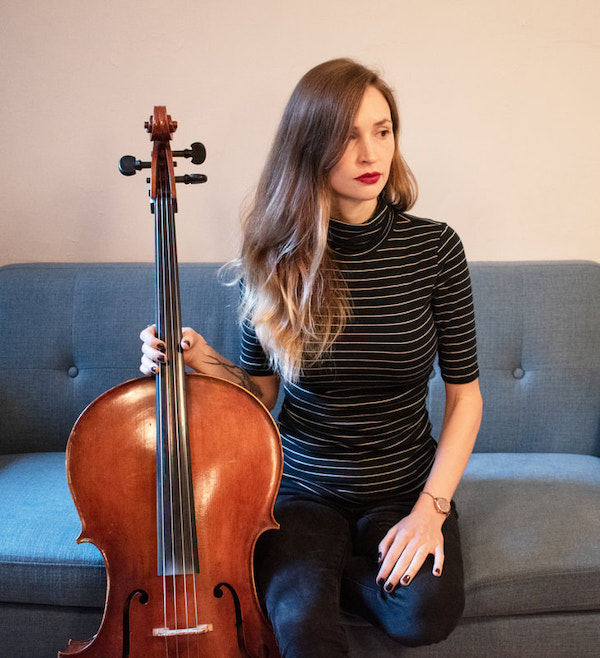Mumford premiere highlights contemporary program by String Orchestra of Brooklyn

Even though it’s part of New York City, Brooklyn has a larger population than cities with major orchestras, like Cleveland, Philadelphia, San Francisco, and Boston. Yet the Borough hasn’t had its own orchestra since the collapse, due to mismanagement, of the Brooklyn Philharmonic a decade ago.
The String Orchestra of Brooklyn partly fills that gap, if not in size then in quality. Ably led by conductor Eli Spindel, this skilled string ensemble is not a specialty group and plays repertoire from the 18th to the 21st century.
Thursday night at St. Anne & The Holy Trinity Church in Brooklyn Heights, the program was all contemporary—three pieces completed in 2020, with one world premiere. The concert celebrated the released of the orchestra’s new CD, “Enfolding.”
The first two works—Outside Only Sound by Scott Wollschleger and Leilehua Lanzilloti’s with eyes the color of time—shared attractive ideas and sounds, and also shared the same drawback. The premiere of Jeffrey Mumford’s brightness dispersed, which closed the evening, was a complete success.
Wollschleger’s piece was built around an interesting challenge: the SOB asked him for a work that could both be played outside and demanded little or no rehearsal. His solution was to set the musicians apart from each other-—there were some scattered in the aisles of the church—and to string together a small bunch of simple directions without strict notation to build to a climactic moment.
This began with beauty and atmosphere. Before any strings, the musicians played small bells muted with their hands. The quiet ticking sound was like being surrounded by metallic insects. This moved to whispery long tones and tremolos, still quiet. This was soft and evocative music, as simple as could be, that focused attention and created the kind of concert experience that is separated from the world.
Then the piece moved to scraping and growling, bow on strings, and that focus was broken. The sounds in and of themselves weren’t an issue—it was that they went jarringly against the context that had just been built. The quiet, deliberate sounds showed off Wollschleger’s thinking, the way he heard structure, what was beautiful to him. The language was personal, but the scraping was a gesture, a tool that has been around for 70 years and capitalized on by dozens of composers—well past the point where it can stand on its own. With it, the music no longer sounded like Wollschleger’s; it just sounded generic. After a loud climax, the metallic ticking returned, but the reprise felt distant and objective.
Lanzilotti’s piece took the exact same misstep—that this happened in both these recent works might indicate an unfortunate trend—but recovered.
A finalist for the 2022 Pulitzer Prize in Music, the music was inspired by the composer’s experiences in the now defunct Contemporary Museum in Honolulu. In an arch shape, it began with quiet, long tones in the violas, one single pitch for long stretches, pressed forward at times by a leading tone. This was followed by the barely audible sound of the cellos bowing on the bridge. The single-mindedness was both provocative and peaceful, Beckett-like in the way it it worked through one single idea, building a world within. With such minimal material, each slight change had great drama and effect.
But here too the music turned to effects, and the piece had a stretch of generic modernism. The music did find its way back to itself, via some Nyman-esque minor-key repeated phases that reentered everything, and ending with the haunting, gorgeous sound of close-mouthed singing and humming from the musicians. Played with great concentration, this was a near-masterpiece.
Mumford’s work was an SOB commission, a pocket concerto with cellist Mariel Roberts as soloist. Mumford’s style was completely different from the first two works, an expressionistic high modernism that was something of a throwback but so well done, so clearly the composer’s individual voice, that is was neither old-fashioned nor anachronistic; it was refreshing.
The writing gave the SOB is a chance to show how fine they are. The four movements had traditional markings like Maestoso and Capriccioso, but the central pulse and ideas were so consistent that this was close to a single, uninterrupted work. The movements themselves were tremendously succinct, statements that moved like one-sentence paragraphs, concluding abruptly but logically with no waste, no fuss, and no concessions to traditional formal demands. After the first movement, one was a little disoriented, but quickly and eagerly began to anticipate it.
Roberts played vibrantly, her part alternating between slashing phrases and short, lyrical ideas. Her part flowed into and through the polyphonic accompaniment. Everything was stimulating, to the point where the attention gladly bounced between Roberts and the orchestra and back.
The final movement, Molto appassionato, was built off of extended harmonies that floated in an intriguing liminal space between tonality and freedom, and a demanding compositional idea played with excellent intonation and a glassy string quality. Roberts, meanwhile, plunged through to the final period. The precise ending left one wanting to hear this again.
The String Orchestra of Brooklyn plays music of Brahms and Haydn, with trumpeter Brandon Ridenour, 8 p.m. November 12. thesob.org
Posted Oct 08, 2022 at 1:23 pm by Jeffrey Mumford
Thank you so much for your kind comments about my concerto!
Both Mariel and the orchestra were brilliant!